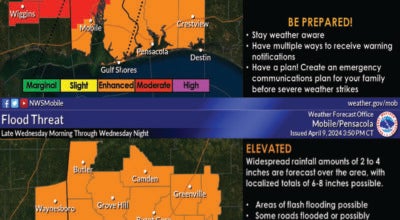Project Lifesaver devices tested
Published 9:16 am Monday, September 19, 2011
A missing Brewton man brought attention to the need for tracking devices for those who may become lost from their homes — and the Escambia County Sheriff’s Department used it as an opportunity to bring devices used for that purpose to the attention of the public.
“We already have a system in place that will help in these kinds of situations,” Sheriff Grover Smith said. “Project Lifesaver is already in use in this county and we want our citizens to be aware of the benefits of the device.”
Smith conducted a training session Friday morning at the Brewton Municipal Airport to refresh the knowledge among officers who would be involved in a search for missing people.
“We are here for the people of this county and this is just another way we can remain prepared to be of service,” Smith said. “This session helped us determine what the devices will and will not do. It’s an excellent exercise that allows us to find out what we don’t know and change that.”
Chief Deputy Mike Lambert said more than a dozen citizens in the county are already part of the Project Lifesaver system.
“The device is typically worn as a bracelet,” Lambert said. “It can be worn several ways and all of them would be a help to law enforcement or other emergency workers if someone should become lost.”
The system is in place at no charge to the citizen who is in danger of becoming lost, Lambert said.
“We don’t charge anything for the device, maintenance or monitoring,” Lambert said. “The cost of the system and all of the devices is covered by contributions that make it possible for us to provide them to our citizens.”
Farrah Gibson oversees the registration and use of the devices for the county, and, she said there are only a few requirements necessary in order to receive the service.
“We just want people to call and we’ll get them started,” Gibson said. “There is an application that has to be completed and we need a letter or note from the person’s physician stating the service would be beneficial or needed for that individual. That’s all there is to it. We are ready to help.”
Gibson said the cost of the devices is paid for by contributions from businesses and individuals who see the benefits and importance of having the system in place.
“We want to be able to provide this service to those who need it at no cost,” Gibson said. “We are always happy to take donations to cover the cost of the devices. The transmitters alone are about $200 each. There is an added cost for the batteries and bracelets that runs about $200 for a six months supply of batteries for eight devices.”
Currently Gibson said 14 Escambia County residents are using the system and one resident in Conecuh County is already on the system as well.
“We continue to take calls and complete applications for the devices,” Gibson said. “We have two more people we are working with to get on the system.”
Smith said the biggest obstacle for having residents begin the program is the potential wearer of the device.
“We have people who really don’t think they need to have this device,” Smith said. “Sometimes that’s the case. But for those who really need it, we want to encourage their families to help convince them how important it could be in an emergency.”
Lambert said the transmitting signal can help locate the wearer from three miles on the ground and up to 12 miles from the air.
“A lot of that has to do with the terrain and conditions,” Lambert said. “In Mr. Blair’s case, he was found about 10 miles from home. If he had been wearing the device, we may have been able to locate him more quickly.”
To learn more about the Project Lifesaver program and devices, contact the Escambia County Sheriff’s Department at 867-0304.





